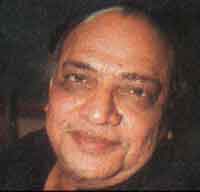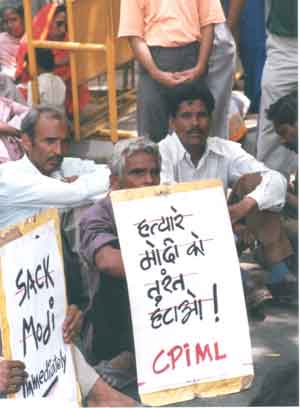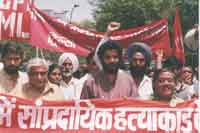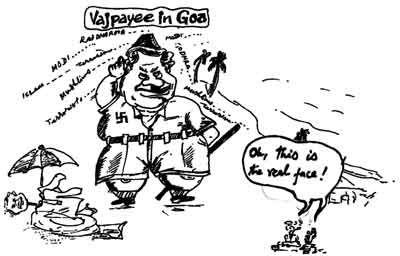 Q:
Why is Gujarat witnessing anti-minority violence and riots at regular intervals?
How do you explain the recent large-scale massacre of Muslims?
Q:
Why is Gujarat witnessing anti-minority violence and riots at regular intervals?
How do you explain the recent large-scale massacre of Muslims?
– Achyut Yagnik
[Achyut Yagnik, a well-known journalist and activist from Gujarat, talks to Srikant from Liberation about minority cleansing in the state.]
 Q:
Why is Gujarat witnessing anti-minority violence and riots at regular intervals?
How do you explain the recent large-scale massacre of Muslims?
Q:
Why is Gujarat witnessing anti-minority violence and riots at regular intervals?
How do you explain the recent large-scale massacre of Muslims?
A: There can be no straightforward answer as to why Gujarat is witnessing so many riots. The first big riot took place in 1969. The most affected area was the walled city of Ahmedabad and the industrial belts, i.e., the area of the textile mills. And whatever figures the government might have provided, not less than 2000 people were killed. Even today, if you look back at the last 50 years, the 1969 riots were the largest in terms of intensity of killings. Then in 1981 you find the first anti-reservation agitation in Ahmedabad and dalits were the victims. Again in 1985 there were riots against the OBCs. It was basically against reservation quota for the OBCs. So even before the Mandal Commission, you see sort of “anti-Mandal agitation” in Gujarat. And this anti-reservation agitation degenerated into communal riots. Then there were a series of riots in Gujarat – in 1986, in 1987, again in 1989. Then in 1990 there were major riots spread all over Gujarat when Advani’s Rath Yatra was stopped and Advani arrested. This Rath Yatra started from Somnath for Ayodhya. Somnath, as you will find in the map, is in Saurashtra and the Rath Yatra covered a long route in Gujarat. You will find that riots broke out in all the areas covered by the Yatra. Earlier, Surat (an industrial city) used to be immune to communal riots. But in 1993 (in the wake of Babri Masjid demolition), Surat witnessed large-scale rioting. From 1993 to 2000, there were no anti-Muslim riots. In tribal areas, in 1997, the RSS engineered anti-Christian riots. It was not a big affair in 1997. However, as soon as the BJP came to power in 1998, it grew big.
How to interpret this? That’s a big challenge. In Gujarat, after independence particularly, a new type of middle class came into existence because of the typical manner of industrialisation and urbanisation here. There already existed a settled middle class because of the industrialisation that started 150 years back. The first textile mills in Ahmedabad started in 1861. Barring Calcutta and Bombay, industrialisation in Gujarat was more rapid compared to any other area. A lot of urban centres also came up side by side as a consequence. If you leave out Bombay [Maharashtra], then Gujarat ranks first in terms of rate of urbanisation. Secondly, in Gujarat, the medium level towns like district headquarters and block headquarters have become large urban centres as compared to other states. Hence a big chunk of the middle class has come up here. We often say, this is ‘urban India’...this is ‘rural India’. This urban-rural divide is not there in Gujarat, except for the tribal belts, because of rapid industrialisation and urbanisation. This middle class is basically upper caste, plus some intermediate castes, certain castes from the OBCs. We have a sizable middle class from dalits and OBCs also because of better educational levels and because of greater reservation in government services compared to other states. Now this middle class that has emerged needed an identity. An identity that could be a meaningful and powerful big identity. The middle classes think Hindutva is that identity and that is why they are attracted to the Hindutva philosophy, and consequently, to Sangh Parivar and BJP’s Hindutva politics also. This is one way of looking at it.
 Secondly,
we have no left tradition like Maharashtra. Communist parties have never been
strong here. Because, from 1942 onwards the Congress continuously conducted
anti-communist propaganda. In Gujarat, even if you talk a little on tribal or
dalit rights or on any other progressive issue, you’ll be called a lallia (meaning
red, an allusion to the colour of the communist flag). Without knowing your
ideology, people will call you a lallia. The trade union here has been under
total control of the Congress. This trade union is called Majoor-Mahajan and
to maintain its monopoly the Bombay Industrial Act is implemented in Gujarat.
Because of this Act, only this Congress union, which came up in the Gandhian
tradition, was accorded recognition. Other unions were not recognised. But because
of the Congress control very little actual union activity took place.
Secondly,
we have no left tradition like Maharashtra. Communist parties have never been
strong here. Because, from 1942 onwards the Congress continuously conducted
anti-communist propaganda. In Gujarat, even if you talk a little on tribal or
dalit rights or on any other progressive issue, you’ll be called a lallia (meaning
red, an allusion to the colour of the communist flag). Without knowing your
ideology, people will call you a lallia. The trade union here has been under
total control of the Congress. This trade union is called Majoor-Mahajan and
to maintain its monopoly the Bombay Industrial Act is implemented in Gujarat.
Because of this Act, only this Congress union, which came up in the Gandhian
tradition, was accorded recognition. Other unions were not recognised. But because
of the Congress control very little actual union activity took place.
Similarly, in Maharashtra there was a strong Ambedkarite tradition, the tradition of a militant, assertive dalit identity. We lacked this. Or it didn’t grow strong. Unlike Jharkhand where there was a tribal assertion, a strong tribal movement, there has been no movement here. So, Gujarat had no left movement, no dalit movement, no tribal movement and no trade union movement. In the absence of such movements Hindutva would fill the void. So, the RSS has been successful, in the political use of religion. The success is to such an extent that they have taken over the whole of Gujarat. In no other state, the BJP now has even a simple majority on its own, except Gujarat. They were either running a coalition government as in UP and Jharkhand or supporting the government of a coalition partner. Here, in the last panchayat elections that were held prior to the earthquake, the BJP suffered a crushing defeat because it surpassed even the Congress in corruption. A BJP MLA behaved exactly like a Congress MLA or minister. So the people’s hope, that if BJP came to power, things would be put in order, was belied because of similar level of corruption. So people defeated the BJP in panchayats. This was also one factor that made them extremely worried about their future. In the recently held assembly by-elections they lost two out of three seats. They could win the remaining one because the Chief Minister, Narendra Modi was in the fray from that seat. So they got the message loud and clear that Gujarat would go out of their hands and they needed something big to turn the tide. Now, after all this riot and frenzy, they think they are going to get 150 seats. For them it is a political game, it is a political chess they are playing.
Q: How come tribals in Gujarat are also siding with the Saffron forces?
A: You see the system is such that if the tribals convert to some other religion their Scheduled Tribe status would not be taken away whereas if a person from SCs converts to some other religion he/she will lose his/her SC status. Therefore, when tribals convert to Christianity or any other religion or sect their community life is not disturbed. This posed a big challenge to the RSS. The Christian population was 15-16% in the tribal belts of Gujarat. The RSS then engineered a big anti-Christian riot. And the attempt was to break the Congress stronghold in South Gujarat. For the first time a BJP candidate got elected from that parliamentary constituency (Valsad) in the last Lok Sabha elections.
The RSS started saffronising the tribals purely through education. They opened up their Sishu Mandirs (Temples of Education for Kids) in the late 1990s in the tribal belt. Due to this education a section of tribals became middle class. There was saffronisation in a literal sense, too. The RSS painted rocks with saffron and declared it to be Hanuman (Monkey God). So, you see, the tribal youth today have got RSS education and they will act according to what the RSS says.
Q: Women and children have been killed on a large scale in a most barbaric fashion. How could it be explained?
A: You see, the traditional dividing line that women and children should not be killed was broken in Gujarat during the 1987 riots. In the 1969 and 1985 riots, women and children were spared even when there was rioting on a large scale. In the present riots too, you will find major episodes of mass burning only at two places. The first one at the Gulbarga Society where the ex-Congress MP Ehsaan Jaffri and his family members were burnt alive. The second is at Naroda Patia, where Muslims were burnt on a large scale.
 You
shouldn’t forget that in cases of dowry deaths most women are burnt alive, and
the family members prove it to be a “suicide case”, and then the government
authorities also call it “unnatural death of a woman”. In Gujarat, dowry deaths
are rampant. About 15,000 young women have been killed in the last 4 years alone.
Now, if they can burn their daughters-in-law, they can also easily burn Muslim
women and children. Gujarat actually is a very cruel society. All such notions
of this being a Gandhian state, mercantile state, a peaceful state etc. are
just balderdash. I know about Gujarat. We have run the slave trade. We Gujaratis
controlled Eastern-African slave trade. So, when we could trade humans as slaves,
burn our own women for dowry, this medieval cruelty was already there in trade
and within the family, and now it has just manifested in a different fashion.
You
shouldn’t forget that in cases of dowry deaths most women are burnt alive, and
the family members prove it to be a “suicide case”, and then the government
authorities also call it “unnatural death of a woman”. In Gujarat, dowry deaths
are rampant. About 15,000 young women have been killed in the last 4 years alone.
Now, if they can burn their daughters-in-law, they can also easily burn Muslim
women and children. Gujarat actually is a very cruel society. All such notions
of this being a Gandhian state, mercantile state, a peaceful state etc. are
just balderdash. I know about Gujarat. We have run the slave trade. We Gujaratis
controlled Eastern-African slave trade. So, when we could trade humans as slaves,
burn our own women for dowry, this medieval cruelty was already there in trade
and within the family, and now it has just manifested in a different fashion.
Q: Hindutva ideology is blatantly anti-women as you have just cited the case of dowry killings. Why then did women help these same forces on a large scale in killing Muslims?
 A:
This happened in the 1981 and 1985 riots also. This middle class that I talked
about comprises both upper castes as well as intermediate castes. During riots
they all get together and seem to forget their differences. This is a great
Indian contradiction. A saas (mother-in-law) forgets that she was also a bahu
(daughter-in-law) once. This is a contradiction of the entire Hindu society.
When they draw a demarcation line, when they create a communal divide, they
construct this “we” and “them”. What exactly is this “we-ness”? During the 1981
riots dalits were perceived as the “other”, a different people. When Muslims
and Christians were to be targeted, even dalits and tribals were included in
the “we”. How this ‘we’ and ‘they’ are constructed is very important. When ‘we’
is constructed then the whole family is united. When a family member can be
burnt on this basis, others can also be burnt in the same way.
A:
This happened in the 1981 and 1985 riots also. This middle class that I talked
about comprises both upper castes as well as intermediate castes. During riots
they all get together and seem to forget their differences. This is a great
Indian contradiction. A saas (mother-in-law) forgets that she was also a bahu
(daughter-in-law) once. This is a contradiction of the entire Hindu society.
When they draw a demarcation line, when they create a communal divide, they
construct this “we” and “them”. What exactly is this “we-ness”? During the 1981
riots dalits were perceived as the “other”, a different people. When Muslims
and Christians were to be targeted, even dalits and tribals were included in
the “we”. How this ‘we’ and ‘they’ are constructed is very important. When ‘we’
is constructed then the whole family is united. When a family member can be
burnt on this basis, others can also be burnt in the same way.
Q: Do you see any hope for humanity in Gujarat?
A: It will take a lot of time. See, here the whole new generation that came up in the last 20 years or so has witnessed only riots. In the name of values and ideology they have only received the Hindutva philosophy. And I’m sure the same is true for Muslims. Whatever Hindus are taught in mandirs the Muslims are also taught the same, from their point of view, in masjids and elsewhere. Fundamentalism is there on both sides. And, secondly, as I told you earlier, here we didn’t have a left tradition; the Gandhian tradition has ended, class consciousness never emerged here sharply as the left didn’t make a space here, there was no trade union movement, no powerful, assertive and militant dalit or tribal movement…then what else would you expect other than this!